Zulu (1964 film)
7.8 /10 1 Votes
Duration Language English | 7.8/10 IMDb Genre Drama, History, War Music director J.J. Barry Country United KingdomUnited States | |||||||||||||||||||||||||||||||||
 | ||||||||||||||||||||||||||||||||||
Writer John Prebble (original screenplay), Cy Endfield (original screenplay), John Prebble (suggested by an article written by) Initial release January 22, 1964 (United Kingdom) Cast (Lt. John Chard R.E.), (Rev. Otto Witt), (Margareta Witt), (Pte. Henry Hook), (Lt. Gonville Bromhead), (Colour Sgt. Frank Bourne) Similar movies The Most Dangerous Woman Alive , City of Blood , Laser Mission , Gandhi , Purgatory , Live Wire: Human Time Bomb Tagline Dwarfing the mightiest! Towering over the greatest! | ||||||||||||||||||||||||||||||||||
Zulu is a 1964 epic war film depicting the Battle of Rorke's Drift between the British Army and the Zulus in January 1879, during the Anglo-Zulu War. It depicts 150 British soldiers, many of whom were sick and wounded patients in a field hospital, who successfully held off a force of 4,000 Zulu warriors.
Contents
- Zulu theatrical movie trailer 1964
- Plot
- Cast
- Production
- Historical accuracy
- The regiment
- The Witts
- The men of the regiment
- The Zulus
- Ending
- Reception
- Presentation format
- Awards and honours
- Home video releases
- Merchandising
- In popular culture
- References
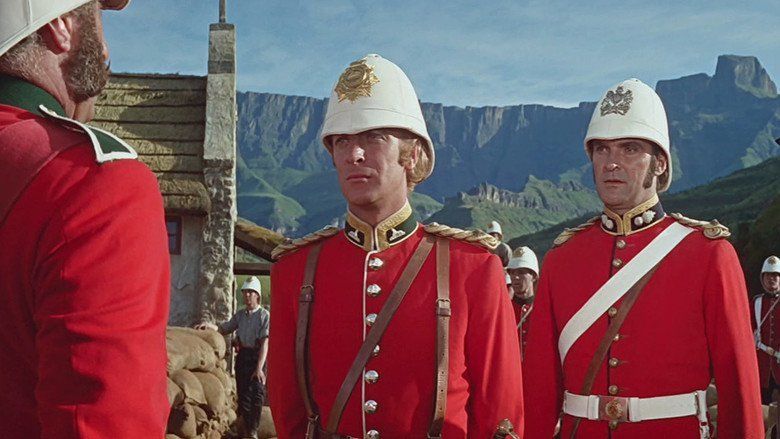
The film was directed by American screenwriter Cy Endfield and produced by Stanley Baker and Endfield, with Joseph E. Levine as executive producer. The screenplay is by John Prebble and Endfield, based on an article by Prebble, a historical writer. The film stars Stanley Baker and introduces Michael Caine, in his first major role, with a supporting cast that includes Jack Hawkins, Ulla Jacobsson, James Booth, Nigel Green, Paul Daneman, Glynn Edwards, Ivor Emmanuel and Patrick Magee. Future South African political leader Mangosuthu Buthelezi played Zulu King Cetshwayo kaMpande, his great grandfather. The opening and closing narration is spoken by Richard Burton.
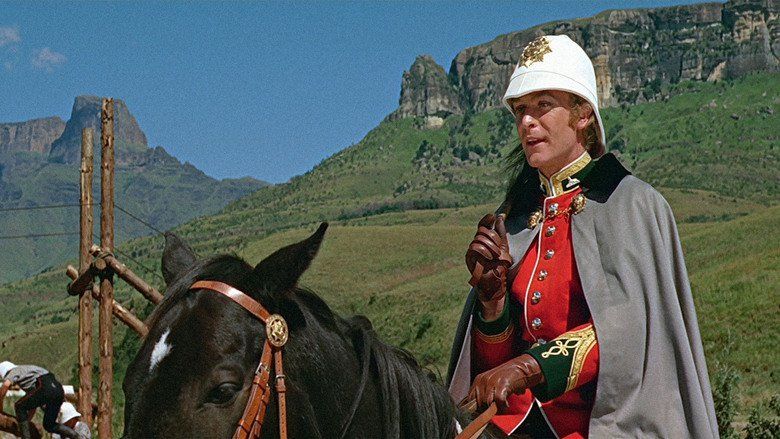
The film was first shown on the 85th anniversary of the actual battle, 22 January 1964 at the Plaza Theatre in the West End of London.
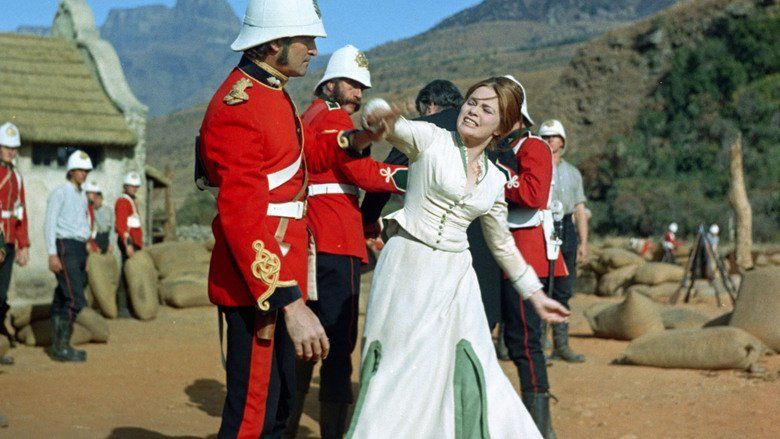
Zulu theatrical movie trailer 1964
Plot

In 1879, a communiqué from Lord Chelmsford to the Secretary of State for War in London (voice-over narration by Richard Burton) details the crushing defeat of a British force at the hands of the Zulus at the Battle of Isandlwana. In the aftermath of the battle, the victorious Zulus walk amongst the scattered bodies of dead British soldiers and gather their rifles. At a mass Zulu marriage ceremony witnessed by missionary Otto Witt Jack Hawkins and his daughter Ulla Jacobsson, Zulu King Cetewayo (Chief Mangosuthu Buthelezi) is also informed of the great victory.
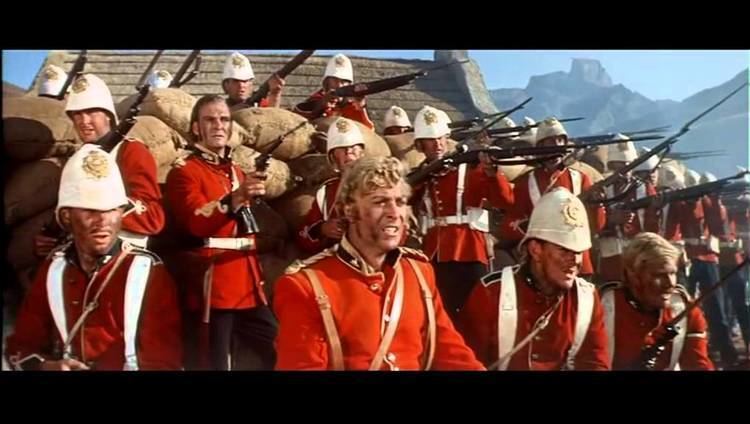
A company of the British Army's 24th Regiment of Foot is using the missionary station of Rorke's Drift in Natal as a supply depot and hospital for their invasion force across the border in Zululand. Receiving news of Isandhlwana from the Natal Native Contingent Commander Adendorff, who warns that an army of 4,000 Zulu warriors is advancing to the British position, Lieutenant John Chard (Stanley Baker) of the Royal Engineers assumes command of the small British detachment. Lieutenant Gonville Bromhead (Michael Caine), an infantry officer, is rather put out to find himself subordinate to an engineer due to the latter's slightly earlier commission. Realising that they cannot outrun the Zulu army with wounded soldiers, Chard decides to make a stand at the station, using wagons, sacks of mealie, and crates of ship's biscuit to form a defensive perimeter. Witt becomes drunk and demoralises the men with his overtly dire predictions; the soldiers of the Natal Native Contingent desert. Chard orders Witt to be locked up in a supply room.
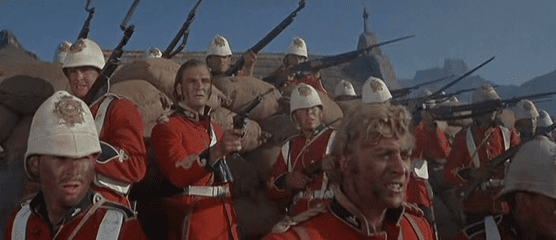
As the Zulu impis approach, a contingent of Boer horsemen arrives. They advise Chard that defending the station is hopeless. They retreat in haste, despite Chard's desperate pleas for them to stay. The Zulu army approach and then charge. The British open fire, but Adendorff informs them that the Zulus are only testing the British firepower. Witt again predicts the soldiers' inevitable fate, before being driven from the battle with his daughter. Chard is concerned that the northern perimeter wall is undermanned and realises that the attack will come from all sides. The defenders are surprised when the Zulu warriors open fire on the station with rifles, taken from the British dead at Isandlwana.
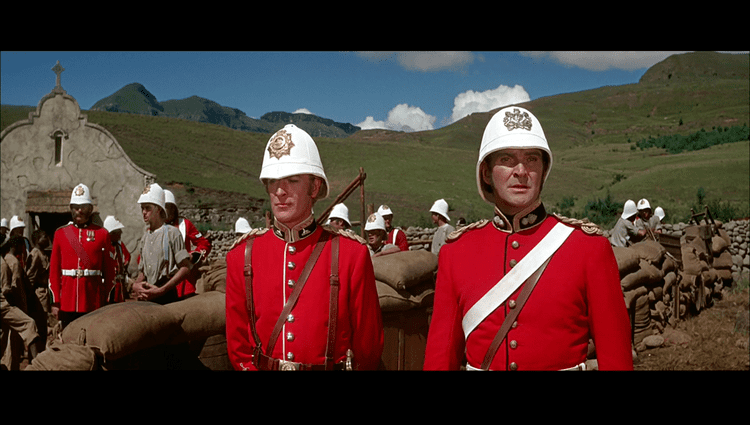
Throughout the day and night, wave after wave of Zulu attackers are repelled. The Zulus succeed in setting fire to the hospital, leading to intense fighting between British patients and Zulu warriors as the former try to escape the flames. Private Henry Hook (James Booth) takes charge and successfully leads the patients to safety.

The next morning, the Zulus approach to within several hundred yards and begin singing a war chant; the British respond by singing "Men of Harlech". In the final assault, just as it seems the Zulus will finally overwhelm the tired defenders, the British soldiers fall back to a small redoubt constructed out of mealie bags. With a reserve of soldiers hidden within the redoubt, they form into three ranks and seamlessly fire volley after volley, inflicting heavy casualties; the Zulus withdraw. After a pause of three hours, the defenders are still recovering when the Zulus re-form again on the Oscarberg. Resigned to another assault, the British are astonished when the Zulus instead sing a song to honour the bravery of the defenders before departing.

The film ends with another narration by Richard Burton, listing the eleven defenders who received the Victoria Cross for the defence of Rorke's Drift, the most awarded to a regiment in a single action up to that time.
Cast
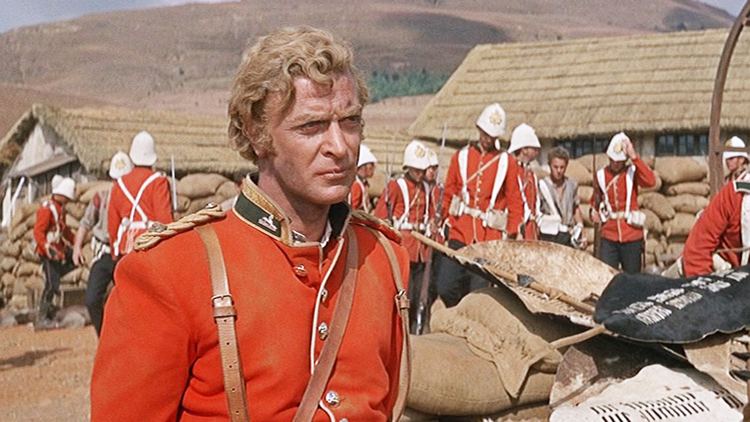
Production
Cy Endfield was inspired to make the film after reading an article on the Battle of Rorke's Drift by John Prebble. He took it to actor Stanley Baker with whom he had made several films and who was interested in moving into production. Endfield and Prebble drafted a script, which Baker then showed to Joseph E. Levine while making Sodom and Gomorrah (1962) in Italy. Levine agreed to fund the movie, which was produced by Baker's company, Diamond Films. It was shot using the Super Technirama 70 cinematographic process, and distributed by Paramount Pictures in all countries excluding the United States, where it was distributed by Embassy Pictures.
Most of Zulu was shot on location in South Africa. The mission depot at Rorke's Drift was recreated beneath the natural Amphitheatre in the Drakensberg Mountains (considerably more precipitous than the real Rorke's Drift, which is little more than two small hills). The set for the British field hospital and supply depot at Rorke's Drift was created near the Tugela River with the Amphitheatre in the background. The real location of the battle was 100 kilometres (60 mi) to the northwest, on the Buffalo River near the isolated hill at Isandhlwana.
Other scenes were filmed within the national parks of KwaZulu-Natal. Interiors and all the scenes starring James Booth were completed at Twickenham Film Studios in Middlesex, England. The majority of the Zulus were real Zulus. 240 Zulu extras were employed for the battle scenes, bused in from their tribal homes over 100 miles away. Around 1,000 additional tribesmen were filmed by the second unit in Zululand.
The film was compared by Baker to a Western movie, with the traditional roles of the United States Cavalry and Native Americans taken by the British and the Zulus respectively. Director Endfield showed a Western to Zulu extras to demonstrate the concept of film acting and how he wanted the warriors to conduct themselves. It has been rumoured that due to the apartheid laws in South Africa, none of the Zulu extras could be paid for their performance and that, consequently, Endfield circumvented this restriction by leaving them all the animals, primarily cattle, used in the film. This allegation is incorrect, as all of the Zulu extras were paid in full – the main body of extras were paid the equivalent of nine shillings per day each, additional extras eight shillings, and the female dancers slightly less.
Michael Caine, who at this early stage in his career was primarily playing bit parts, was originally up for the role of Private Henry Hook, which went to James Booth. According to Caine, he was extremely nervous during his screen test for the part of Bromhead, and director Cy Endfield told him that it was the worst screen test he had ever seen, but they were casting Caine in the part anyway because the production was leaving for South Africa shortly and they had not found anyone else for the role. Caine also believed that he was fortunate that the film was directed by an American (Endfield), because "no English director would've cast me as an officer, I promise you, not one," due to his Cockney roots.
Caine's performance in Zulu won him praise from reviewers, and his next film role would be as the star of The Ipcress File in which he was reunited with Nigel Green.
One technical problem the armorers and the director had to deal with concerned the rifles used during the filming. The company was unable to obtain enough Martini-Henry rifles to equip all of the extras, and had to fill in with No.1 Mark IV Enfields disguised with socket bayonets as used on the Martini-Henrys. In the scene at 1:37:30 where Chard orders a walking advance and volley fire by ranks, the cocking pieces can be seen moving forward as the men shoot, and one kneeling man can even be seen working the bolt on his rifle. Generally, in any scene shot from the soldiers' left, the rifles being used are Enfields; in any scene shot from the right, Martini-Henrys.
Historical accuracy
The basic premises of the film are true and largely accurate. The heavily outnumbered British successfully defended Rorke's Drift more or less as portrayed in the film. Writer Cy Endfield even consulted a Zulu tribal historian for information from Zulu oral tradition about the attack. There are, however, a number of historical inaccuracies in the film, most of which are of minor importance and some of which were added for dramatic effect:
The regiment
The Witts
There are several inconsistencies with the historical record concerning the Swedish missionaries, the Witts. In the film, Witt is depicted as a middle-aged widower, a pacifist and drunkard, who has an adult daughter called Margareta. In reality, Otto Witt was aged 30 and had a wife, Elin, and two infant children. Witt's family were 30 kilometres (19 mi) away at the time of the battle. On the morning of the battle, Otto Witt, with the chaplain, George Smith and Surgeon-Major James Henry Reynolds had ascended Shiyane, the large hill near the station, and noticed the approach of the Zulu force across the Buffalo River. Far from being a pacifist, Witt had co-operated closely with the army and negotiated a lease to put Rorke's Drift at Lord Chelmsford's disposal. Witt made it clear that he did not oppose British intervention against Cetshwayo. He had stayed at Rorke's Drift because he wished "to take part in the defence of my own house and at the same time in the defence of an important place for the whole colony, yet my thoughts went to my wife and to my children, who were at a short distance from there, and did not know anything of what was going on". He therefore left on horseback to join his family shortly before the battle.
The men of the regiment
The Zulus
The attack on the mission station was not ordered by King Cetshwayo, as the audience is led to believe in the film. Cetshwayo had specifically told his warriors not to invade Natal, the British Colony. The attack was led by Prince Dabulamanzi kaMpande, the King's half-brother, who pursued fleeing survivors at Isandlwana across the river and then moved on to attack Rorke's Drift. Although almost 20,000 rounds of ammunition were fired by the defenders, just under 400 Zulus were killed at Rorke's Drift. A similar number were left behind when the Zulus retreated, being too badly wounded to move. Comments from veterans many years after the event suggest the British killed many of these wounded men in the battle's aftermath, raising the total number of Zulu deaths to over 700.
Ending
The ending of the film is somewhat fictitious. There was no Zulu attack at dawn on 23 January 1879, which in the film led to the singing of "Men of Harlech". There was only sparse fighting with a few remaining Zulus.
However at roughly 7:00 am, an Impi suddenly appeared, and the British manned their positions again. No attack materialised, as the Zulus had been on the move for six days prior to the battle. In their ranks were hundreds of wounded, and they were several days' march from any supplies.
Around 8:00 am, another force appeared, the defenders abandoned their breakfast and manned their positions again. The approaching troops were the vanguard of Lord Chelmsford's relief column.
The Zulus did not sing a song saluting fellow warriors, and they did not depart peacefully. They departed at the approach of the British relief column.
Reception
On its initial release, in 1964, it was one of the biggest box-office hits of all time in the British market. For the next 12 years it remained in constant cinema circulation before making its first appearance on television. It then went on to become a television perennial, and remains beloved by the British public.
Zulu received highly positive reviews from critics. Robin Clifford of Reeling Reviews gave the film four out of five stars, while Brazilian reviewer Pablo Villaça of Cinema em Cena (Cinema Scene) gave the film three stars out of five. Dennis Schwartz of Ozus Movie Reviews praised Caine's performance, calling it "one of his most splendid hours on film" and graded the film 'A'.
Although actual participants of the battle are named characters in the film, they bear little resemblance to historical accuracy. The most controversial portrayal is the one of Private Hook who is depicted as a thief and malingerer (the real Hook was a model soldier and teetotaller). His elderly daughters were so disgusted with the Zulu character, they walked out of the London premiere in 1964. The fictional depiction has led to an ongoing campaign to have the historical reputation restored to the real Private Hook. The film's producers admitted they chose Hook simply because "they wanted an anti-hero who would come good under pressure".
Rotten Tomatoes gives a score of 93% based on reviews from 15 critics.
Presentation format
Zulu was filmed in Technirama and intended for presentation in Super Technirama 70, as shown on the prints. In the UK however, the only 70mm screening was a press show prior to release. While the vast majority of cinemas would have played the film in 35mm anyway, the Plaza's West End screenings were of the 35mm anamorphic version as well rather than, as might have been expected, a 70mm print. This was due to the UK's film quota regulations which demanded that cinemas showed 30% British films during the calendar year (the regulations only applied to 35mm presentations). By 1964 the number of British films available to a cinema like the Plaza could be limited and Zulu gave them several weeks of British quota qualification if played in 35mm. In other countries the public did get to see the film in 70mm.
Awards and honours
Ernest Archer was nominated for a BAFTA Award for Best Colour Art Direction on the film. The magazine Total Film (2004) ranked Zulu the 37th greatest British movie of all time, and it was ranked eighth in the British television programme The 100 Greatest War Films. Empire magazine ranked Zulu 351st on their list of the 500 greatest films.
Home video releases
In the US, Zulu lapsed into the public domain from 1991 until 2000, so that there were several releases of the film on home video/Laserdisc/DVD in North America – most notably a LaserDisc release by The Criterion Collection which retains the original stereophonic soundtrack taken from a 70mm print.
An official DVD release (with a mono soundtrack as the original stereo tracks were not available), was later issued by StudioCanal through Metro-Goldwyn-Mayer. The film was released on Blu-ray in the UK in 2008; this version is region-free and will work in any Blu-ray player. On 22 January 2014, Twilight Time issued a limited-edition Blu-ray of Zulu in the US with John Barry's score as an isolated track; the release date being the 50th anniversary of the film and the 135th anniversary of the actual battle.
Merchandising
In popular culture
References
Zulu (1964 film) WikipediaZulu (1964 film) IMDb Zulu (1964 film) themoviedb.org
